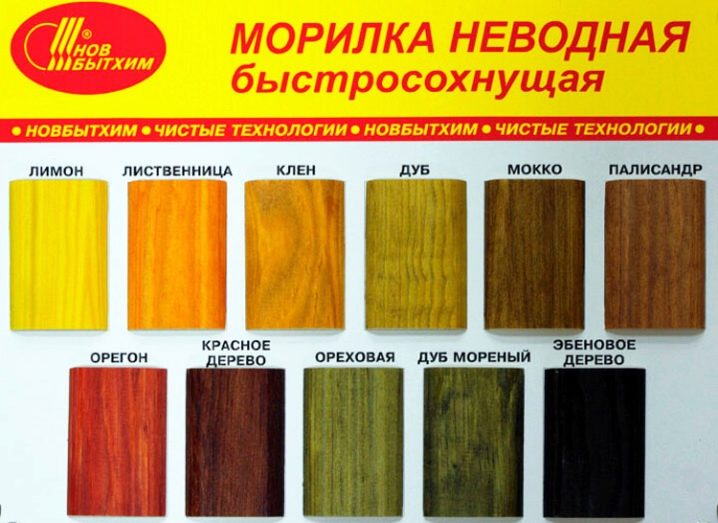Non-aqueous stains: characteristics and scope

Stain is a material that is used to give wood products a specific shade. One of the types of these products is non-aqueous solutions. Let's see what they are and where they are used.

What is it for
The effect of a non-aqueous stain is the same as that of formulations based on water: the varnish penetrates into the wood fibers, impregnating them, and creates a protective film. The composition gives the wood a tone, protects the wood from decay and various insects. In addition, this substance is able to emphasize the structure of wood, making the pattern on it more expressive.

Views
There are several types of non-aqueous stains. They differ in the substance from which the base of the composition is made.
- Alcoholic. It contains aniline dye, which is dissolved in industrial alcohol. The main advantage of this type is that the alcohol evaporates rather quickly and the stain dries up in a short period of time. But this fact can be attributed to the disadvantages. It is almost impossible to apply the composition evenly by hand. But this problem is easily solved by using a spray gun.

- Oil. Here, synthetic oil ("White Spirit") acts as a base. It fits well on the product. It can be applied with a swab or brush, the composition lies evenly and penetrates deeply into the tree. At the same time, the structure of the tree is not destroyed, and a fairly strong protective film is created on the surface.
- Wax. This is an innovative composition that perfectly protects wood from harmful factors. In addition, the color gamut of these products is quite wide. The disadvantage of this coating is its high cost.
- Whitening. Wood does not always need dark toning. For this purpose, a stain based on hydrogen peroxide and acids was developed. Such a composition is capable of lightening the wood. Most often, this coating prepares gray wood for further painting.

Shades
On the market, you can find a fairly wide range of colors of non-aqueous stains. Most of the compositions help to imitate expensive types of wood on birch, alder, pine products. Wood stain is especially popular. Shades such as teak, beech, oak, wenge, maple, mocha, walnut and ebony are in demand here.
Modern compositions allow you to give wood and many other shades. There are almost all the colors of the rainbow, from yellow to black. The tree structure in this case will also be expressed.

But there are compositions that have absolutely no tone. They are designed only to protect the tree from harmful factors such as ultraviolet light, moisture, bark beetles and others.


How to match the color
When choosing a non-aqueous stain color in a store, do not rely on the pictures on the packaging. You need to ask the seller for samples of wood coated with the appropriate compound. Almost all stores have them.


But even if the seller provides you with such testers, the color you receive may differ, since different types of wood have different absorbencies. Remember that conifers do not absorb stain well because they contain a large amount of resin, and the resulting color will be lighter than deciduous ones. Also, the result will largely depend on the tone of the object itself.
After you have decided on the color you want to paint your product with, you need to determine the required number of layers. To do this, you need to make a test paint. Here it is worth taking either a piece of polished wood that completely coincides with the material from which the object planned to be painted is made, or use a part of the finished product hidden from the eyes.

For a test painting, apply a thin layer of non-aqueous stain and let it dry completely. Next, apply a second layer on top of the first. It should be one third shorter than the previous one. Then, after the second layer has dried, we apply the third, which is only a third of the first. Now you can evaluate the result and select the desired color intensity.

Scope of application
Any wood products are processed with a non-aqueous stain. It can be used for both indoor items, such as furniture, and outdoors. In the second case, whole houses can be stained.


In addition, non-aqueous stains are often used in needlework. With the help of it, wooden jewelry, figurines, wicker baskets made of wicker are tinted. Stain can also be used to paint products made from paper tubes.

Manufacturers, cost and product reviews
On the market, you can find a huge selection of manufacturers who produce non-aqueous stains. There are both domestic and foreign brands here. Here are a few representatives that are in high demand.

Novbytkhim
Petersburg company that produces stains based on organic solvents and synthetic resins. You can dilute such a composition with solvent No.1. Its advantages are fast drying, no wood swelling, protection of the product from fire. Available in a volume of 0.5 l, 20 l, 200 l. Product cost: about 80 rubles for a 0.5 liter container. Buyers speak well of Novbytkhim non-aqueous stain. They notice pretty good quality, fast drying, even layers, budget price. The disadvantages include fairly rapid fading in the open air.

Zar Wood Stain Oil Based
Linseed oil stain. It is rubbed into the wood like a polish, giving it delightful hues. Just one layer is enough. The composition perfectly impregnates the fibers, forming a rigid bond that prevents moisture penetration. The cost of the product is about 1600 rubles for a volume of 0.95 liters. Product reviews are high: the impregnation fits perfectly, dries quickly, and is practically odorless. There were no drawbacks by the buyers, except for the rather high cost.

How to handle wood staining, see the video below.











The comment was sent successfully.